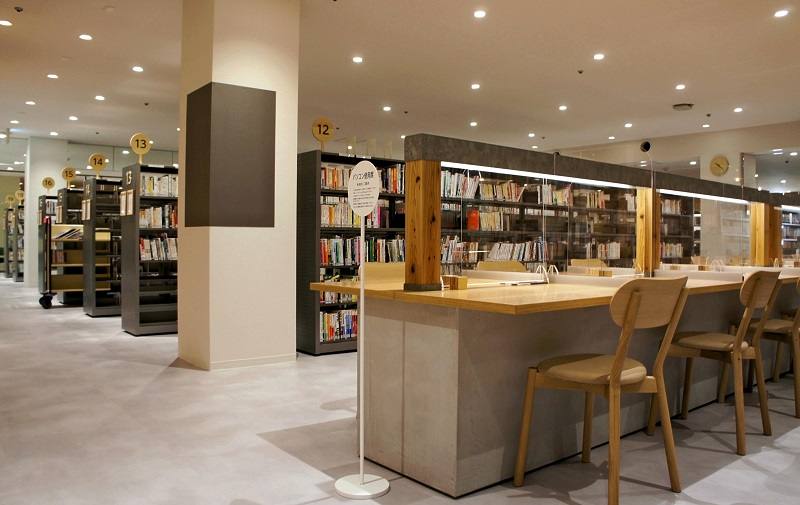
A Kobe municipal library is seen at the Daimaru Suma department store in Kobe.
10:12 JST, April 13, 2021
The prolonged coronavirus crisis has been yet another blow for Japan’s regional department stores, which were already on the back foot dealing with declining and aging local populations and other issues.
While the virus outbreak has hastened the introduction of online and other digital innovations to tackle declining sales, there are no precedents for conducting retailing under a cloud like COVID-19. The following are examples of new concepts Japan’s department stores are trying to rebuild their customer bases and survive in this situation.
Connecting with Tokyo
The renovated Matsuyama Mitsukoshi store in Matsuyama is scheduled to open this autumn. Much of the space on its eight above-ground floors and one basement level will be occupied by third-party restaurants and hotels, with the sales space managed directly by Mitsukoshi limited to floors two to four.
A “digital salon” is to be one of the highlights of the renovated store.
“I think this blouse will look good with your item,” an employee of Mitsukoshi’s flagship Nihombashi store in faraway Tokyo told customers sitting in a spacious reception room in Matsuyama over a videoconferencing system. Any products that are selected are sent over from Tokyo.
The comfortable reception room furnished with sofas and tables is intended to prevent the loss of wealthy customers due to the smaller sales spaces. It also enables the store to operate with fewer employees and a smaller inventory. The company said that a trial run last year was received favorably.
Isetan Mitsukoshi Holdings is considering using such a digital salon in a small store it wants to open this autumn on the former site of a Sogo department store in Tokushima.
Isetan Mitsukoshi Chairman Toshihiko Sugie said, “By going digital, we can use approaches that have never been tried before, even with a smaller sales space.”
Department stores will not be able to survive the slump if they stick to conventional ways.
Kintetsu Department Store has signed franchise agreements with high-end supermarkets Seijo Ishii Co. and Tokyu Hands Inc. at some of its stores, including its Nara outlet, which it operates as the owner.
Kintetsu employees can work in these other retail outlets and keep their status. “We can take advantage of other companies’ ability to procure products and brands,” a Kintetsu official said.
Collaboration
In late March, a branch of the Kobe municipal library opened in the Daimaru Suma department store in Kobe. The department store wanted to create a bustling place and the municipal government was looking for a new site. The library was the product of their mutual interests, and is a rare combination in Japan.
The library has a calming wood decor, with an area where parents can bring their children, and a study space. Since its opening, the number of visitors to the store has increased by 10%.
“Many customers buy things to eat on the food floor on the way home from the library,” the person in charge said.
Daimaru Matsuzakaya Department Stores Co., which operates the space, is considering other such endeavors that can meet local needs, which could include “medical malls” that have several clinics.
In some cases, working with the local community has led to a comeback.
The Saikaya Yokosuka Shopping Plaza in Kanagawa Prefecture decided to close in May last year, but after many residents said they wanted their familiar hometown department store to keep going, the operator changed its mind and reopened in March this year.
The store consolidated from six above-ground floors to four floors. The empty fifth and sixth floors will be used by the Yokosuka city government as a novel coronavirus vaccination site.
“We want to take this opportunity to review product placement in the store and increase the frequency of visits by local residents,” a store official said.
Taketo Yamate of Frontier Management Inc., an expert on the retail industry, said: “It’s difficult to attract people through shopping alone. Department stores need to make use of their locations and transform into places that satisfy various functions, such as offices and hotels.”
Hollowing-out continues
According to the Japan Department Stores Association, there were 196 department stores nationwide as of the end of 2020, down 12 from the previous year.
This was the largest decline ever, and down 40% from the peak in 1999. The size of the department store market in 2020 was ¥4.2 trillion, its lowest level since 1975.
Sales at department stores have been propped up by clothing and other branded products.
Department stores and apparel manufacturers have been able to increase each other’s sales through a system in which unsold inventory is taken over by the apparel makers, and in return, they are free to use the sales floor.
With the recent rise of casual clothing brands like Uniqlo Co., many department stores have started renting out space to apparel makers as tenants to earn rental income.
However, sales have remained stagnant due to factors such as the spread of online shopping. In the past few years, sales to foreign tourists had provided a boost, but this revenue stream disappeared with the outbreak of the coronavirus.
Local department stores tend to be located in downtown areas and hold prime real estate in front of train stations. Figuring out how to use the facilities and sites after a store closes is an urgent and often difficult issue for local governments.
Declining populations are another hurdle for local areas, as the sites are unlikely to be used for condominiums or other such purposes.
"Society" POPULAR ARTICLE
-

M4.9 Earthquake Hits Tokyo, Neighboring Prefectures
-

Israeli Tourists Refused Accommodation at Hotel in Japan’s Nagano Pref., Prompting Protest by Israeli Embassy and Probe by Prefecture
-

M7.5 Earthquake Hits Northern Japan; Tsunami Waves Observed in Hokkaido, Aomori and Iwate Prefectures
-

Tsukiji Market Urges Tourists to Avoid Visiting in Year-End
-

M5.7 Earthquake Hits Japan’s Kumamoto Pref., Measuring Upper 5 Intensity, No Tsunami Expected
JN ACCESS RANKING
-

Keidanren Chairman Yoshinobu Tsutsui Visits Kashiwazaki-Kariwa Nuclear Power Plant; Inspects New Emergency Safety System
-

Imports of Rare Earths from China Facing Delays, May Be Caused by Deterioration of Japan-China Relations
-

Tokyo Economic Security Forum to Hold Inaugural Meeting Amid Tense Global Environment
-

University of Tokyo Professor Discusses Japanese Economic Security in Interview Ahead of Forum
-

Japan Pulls out of Vietnam Nuclear Project, Complicating Hanoi’s Power Plans
























